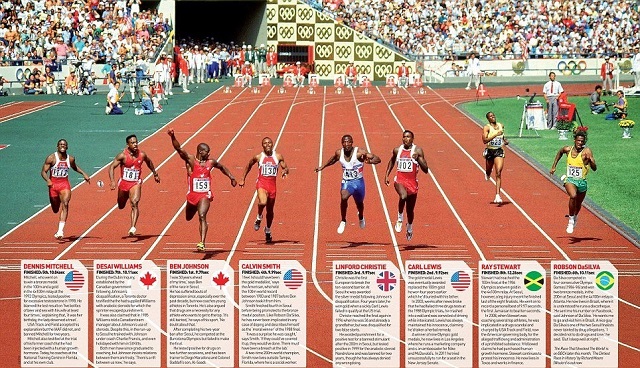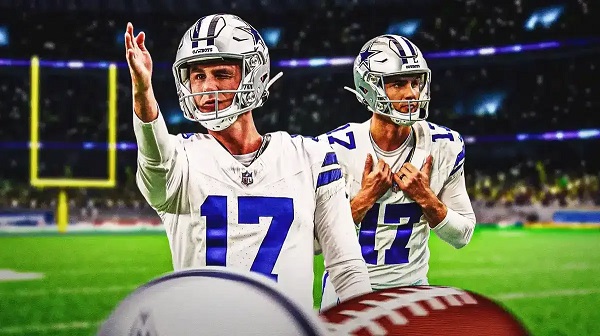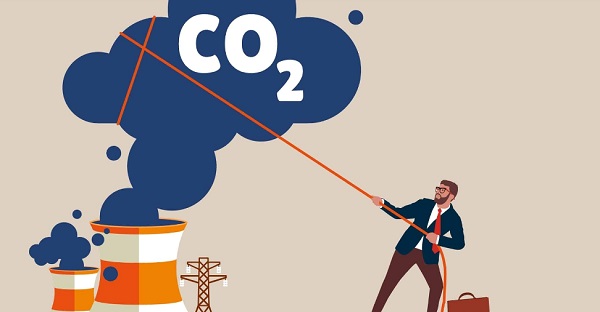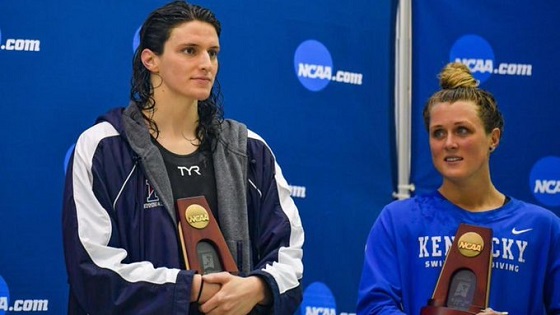Bruce Dowbiggin
Ben Johnson: Can You Railroad A Guilty Man?

The Incredible Life Of Ben Johnson: World’s Fastest Man by Mary Ormsby, Sutherland House, 286 pages
It’s a short list of sports events that Canadians can remember where they were when the story broke. Paul Henderson’s 1972 goal in the USSR Summit Series. The Gretzky Trade. Ben Johnson tests positive after winning the 1988 Olympics 100 metre gold.
It’s long been established that Johnson was guilty on the positive steroid charge. But many questions have lingered for Canadians. Why was Johnson the only one singled out when five other runners in that race have drugging histories? Why did Canadian officials abandon Johnson to his fate in Seoul?
Our friend Mary Ormsby, longtime former reporter at the Toronto Star, has wondered the same things for years. So when Johnson asked her to cooperate on a book, she decided to conduct a cold-case investigation into a story that has flummoxed Canadians for decades. We spoke about The Incredible Life of Ben Johnson: World’s Fastest Man
Why is Ben Johnson still relevant to Canadians 35 years later:? I think, he still strikes a nerve with the Canadian consciousness. He took everybody on that 100-yard run with him in 1988. And then, of course, this historic, disqualification during the Seoul Olympics for his doping offence. That was seared in the Canadian mindset at the time, and I found over the decades that Canadians have never really forgotten about that moment.

People are still curious about him, and I think over time, people have become very much more aware and educated about the prevalence of doping in sport. We were quite naïve as Canadians, at least back in 1988. And we’ve learned a lot more since including that five of the other guys in that 100 metre final, became linked to doping infractions in some way. So it’s a wiser population that thinks that Ben is interesting, and they want to know what happened to him in the interim.
How did you get Ben to agree to the book: Actually, Ben said, “do you think there’s a book in this?” He’s the one who asked me to write it? And I said no, for a long time. Then I said, well, why not look into it after I left the Toronto Star?
What did you discover: The crux of the book is how is it possible to railroad a guilty man? Was he denied or deprived of due process at his hearing in Seoul? A lot of the people I talked to for the book, they all seem to say that Ben got screwed in Seoul. Meaning he wasn’t the only one using something at the time or of that generation or later. Only he was singled out. Now, that’s not to say, Ben is blameless. We all know he broke a rule, he willingly took steroids and he lied about it. He made it bad for himself. But again, I think people have learned to understand sport in a way that is much more cynical and much more educated, through, all the anti-doping news that continues to this very day almost.

That’s one of the questions I really want to explore in the book. So all this is to say it, it came to be at one point.
Why should people read the book?: The way to engage people was to really focus on what I would call the cold case aspect of the Ben Johnson story. And that is how was he represented at that very critical hearing that Monday night in Seoul when it was all or nothing trying to hold on to his gold medal. As I said, Ben is not blameless. We all know what he did. He lied about it. It took a $4 million inquiry and testimony under oath to get the truth out of him. “Yes, I did know what I was doing and yes, I did take steroids.” Then I try to weave the idea that there is an injustice, surrounding the mystique of Ben Johnson that Canadian officials didn’t go to the wall for him, as they should have. It was pretty much an open-and-shut case very quickly. But following the paper trail, you can see where evidence wasn’t looked at, the Canadian officials didn’t even look at his drug test. They just assumed that everything was correct and all the paperwork was absolutely topnotch. Then the IOC Medical Commission members dropped a second test on him that showed he was a longtime anabolic steroid user.
It was an unofficial test, and also no one took exception to the many conflicts of interest of the IOC doping panel that was actually hearing his appeal. They had many conflicts in my opinion. They developed the testing, they ran the testing, they supervised the testing. They were the prosecutor and the judge and the jury. And they were the ones who could recommend whether he be disqualified or not. So, the trick— and I hope I did it properly— was to get people involved in this idea that there was an injustice that happened. You can support someone’s right to a fair hearing and he was entitled to a fair hearing. That doesn’t mean you support or endorse the behaviour. Those are two separate matters.
How did Canadian officials drop the ball?: Ben made it trickier, because he, said yes, please have IOC VP Richard Pound represent me when that option was presented to him that night. Everybody was in total shock. Richard Pound, he stood to lose something too. He was one of the golden boys of the IOC movement. He was hoping to be in the running for next IOC president. From talking to IOC Medical Commission member Arne Ljundqvist after the fact, the panel weren’t very pleased to see him there running the show when, in their opinion, it should have been Canada’s chef de mission Caroline Anne Letheren. I asked Pound, why did you not look at his drug test? Why, did you not look at the supporting paperwork? And he said, you know, I didn’t want to be someone who got somebody off on a technicality. Perhaps, but if you’re fighting for your life, I would like my representatives to go to the wall for me whenever possible.

How was his late coach Charlie Francis responsible for this?: He really did influence Ben and convince him— based on Charlie’s own research and knowledge and beliefs— that everybody at the highest level is using performance enhancing drugs. You know, that famous line, you don’t have to use, but you’re always going to be a metre behind. Ben thought about it for a week or two and said, yeah, let’s do it. Charlie was a huge influence on Ben moving forward. So much so that Ben would claim, when he got caught lying, that he lied to protect Charlie Francis. He didn’t want Charlie to be caught up in the big disaster. To this day he, he talks about Charlie with, with great love and affection. So that was a very strong bond. And Charlie Francis did take advantage of that. Ben was the one who was able to help fill Charlie’s ambition as a coach.
Why wasn’t Ben caught when he set the world record at the Rome 1987 World Track & Field Championships?: Amazingly, he said he wasn’t tested in Rome. In fact, he was in the doping control room, and Primo Nebbiolo’s bodyguard went in to get him (Nebbiolo was president of the World Track & Field Federation). He says, “The boss wants to see you at this horse track”. So he spirited Ben out of the doping control room. Ben went in a limousine to this horse-racing track where he met Primo’s friends and horse racing friends and some championship horse, and then he was eventually taken back to Rome to his hotel. Nobody ever bothered him about providing a urine sample after he set the world record. (Nebbiolo later erased Ben’s 1987 world record for embarrassing him with the incident.)
How Is Ben today?: I think Ben has been broken many times in his life about this, and he tried really hard to fight through it. It’s been a lonely fight. At different times, he surrounded himself with people who didn’t always have his best interests at heart (Muammar Ghaddafi) and he retains a bitterness about Seoul and what happened to him and why he was the only one. But there’s also a resilience there that I’m pretty impressed with, because in all that time he’s had to scramble to make a living. He is still hoping with this book and maybe with more time, he will be able to clear his name. He sees that at the end of the day. I don’t know. But what we do see, even just walking down the street in Toronto or down in Jamaica, people will still call out to him. “Hey, world’s fastest man” and give him the thumbs up. You know, what a great guy.
Bruce Dowbiggin @dowbboy is the editor of Not The Public Broadcaster A two-time winner of the Gemini Award as Canada’s top television sports broadcaster, he’s a regular contributor to Sirius XM Canada Talks Ch. 167. His new book Deal With It: The Trades That Stunned The NHL And Changed hockey is now available on Amazon. Inexact Science: The Six Most Compelling Draft Years In NHL History, his previous book with his son Evan, was voted the seventh-best professional hockey book of all time by bookauthority.org . His 2004 book Money Players was voted sixth best on the same list, and is available via brucedowbigginbooks.ca.
Bruce Dowbiggin
Long-Distance Field Goals Have Flipped The Field. Will The NFL Panic?

It is a day that lives in infamy for Buffalo Bills fans. Jan. 27, 1991, with Buffalo against the New York Giants in Super Bowl XXV. Behind 20-19 with eight seconds left, Scott Norwood, a former All-Pro, attempted a 47-yard game-winning field goal. The kick was, in the immortal words of Al Michaels, wide right.
In the days of the Bills’ four consecutive losing trips to the Super Bowl a 47-yard field goal was within the range of an All Pro kicker. Still it was considered anything but automatic. And kicks of over 50 yards were moon shots with a high degree of failure. Sixty yards? Please, don’t make us laugh.

But as anyone watching field goals in the NFL and CFL can attest the distance barrier has been shattered. NFL kickers are making 72.5 percent of field goals from at least 50 yards. Four kicks have been made from at least 60 yards — one shy of the single-season record. Tampa Bay’s Chase McLaughlin hit a 65 yarder against Philadelphia in Week 4, one yard short of Justin Tucker’s record set in 2021.
Last Sunday Evan McPherson of Baltimore hit a 67-yarder that was wiped out by a late timeout called by Green Bay’ HC Matt LaFleur. (Jacksonville Jaguars kicker Cam Little hit a 70-yard field goal, but it was in preseason and not an official record.)
What makes this onslaught more interesting is that the record for longest FG in the NFL had stood 43 years from Tom Dempsey’s game-winning 63-yarder in 1970 against Detroit for New Orleans. (Dempsey, who has no toes on his right foot wore a special kicking boot.) It took Matt Prater and the light air of Denver to establish a 64 yarder on December 8, 2013. Since then it’s been bombs away.
Dallas’ Brandon Aubrey is the current king of effortless distance, regularly pounding them through from over 60. Many expect him to break the 70-yard mark. (Airlines have movies on flights that long.) No wonder then that the NFL has set records in each of the last four seasons for 50-yard field goals. The total of 195 in 2024 was double the total from every NFL season until 2015.
The combination of distance training plus a few new rules has revolutionized game strategy in today’s game. With the so-called Dynamic kickoff rules forcing more returns, teams are regularly starting drives at the 35- or 40-yard line. In late-game situations top quarterbacks like Buffalo’s Josh Allen or Kansas City’s Patrick Mahomes need to get only a couple of first downs to get in the range of their kickers.

Now, a TD with under a minute left is not the death sentence for teams with one of the better kickers— as Bills fans will remember from their crushing loss in the AFC championship game to the Chiefs in 2022. The game featured 25 points scored in the final two minutes of regulation. The Chiefs took just 11 seconds to get to Harrison’s Butker’s range for a tying 47-yard field goal, then won in overtime.
Once the kicker played another position. Today they are specialists. The science of kicking has also improved with a plethora of kicking camps and coaches springing up to train the latest generation of long-distance drivers of the ball. With only 30 jobs in the NFL the competition is fierce, and only the very best get even a look at the pros, let alone s job. But with the money paid to a steady kicker there are thousands each year refining their craft and strengthening their techniques to get a sniff.
Another innovation improving distance was the league allowing teams to prepare their own kicking balls for games. Now they receive a supply of 60 game balls before the season to use in games. 49ers kicker Eddy Pineiro estimates the broken-in balls add maybe three or four yards to the distance on kicks. The rules stipulate that no artificial heating, stretching or inflating are allowed but Jets kicker, veteran Nick Folk, says that it gives him. Comfort zone.
“We get to kind of do just like quarterbacks get whatever they want to do to the ball, as long as it looks like a football and the logo’s still there and all that stuff,” Folk told AP. “I think they’re pretty lenient with that. It’s a very welcoming thing to be able to kind of look at a ball and be like: ‘All right, I want to kick this one this week, I want to kick this one this week.’”
In the CFL the place-kicking game is about to get a big shock as the league moves goal posts from the goal line to the back of the new, smaller end zones. Kickers will now be forced to kick much further for three points, while offences will play on a smaller field that requires more emphasis on TDs.
Paul McCallum stroked a 63-yard to set the league’s record, and like the NFL, CFL kickers are constantly pushing their range in a league with only one indoor surface. Unlike the NFL, the CFL allows PKers to use a tee. Suffice to say the reconfigured field will take getting used to. (Already traditionalists are fuming.) At least we don’t have the rouge on missed FGs to kick around any more.
For now the quest for a 70-yard field goal continues. The question will be how does the NFL react to re-balance the field’s dynamics to protect the integrity of scoring.
Bruce Dowbiggin @dowbboy is the editor of Not The Public Broadcaster A two-time winner of the Gemini Award as Canada’s top television sports broadcaster, his new book Deal With It: The Trades That Stunned The NHL And Changed hockey is now available on Amazon. Inexact Science: The Six Most Compelling Draft Years In NHL History, his previous book with his son Evan, was voted the seventh-best professional hockey book of all time by bookauthority.org . His 2004 book Money Players was voted sixth best on the same list, and is available via brucedowbigginbooks.ca.
Bruce Dowbiggin
Canada’s Humility Gene: Connor Skates But Truckers Get Buried

My friend and colleague Roy MacGregor used to talk about the “humility gene” in Canada’s hockey heroes. From Gordie Howe to Jean Beliveau to Wayne Gretzky it described the aw-shucks attitude of the top players in the game, who are as Canadian as Roy’s famous canoes.
The refusal to go Hollywood like the NFL, NBA or MLB stars was a defining characteristic of the hockey culture that once bound Canadians. For decades this “fear of flying high” was used by the NHL against the stars when it came to getting paid. Even when players belatedly started a union, their executive director Alan Eagleson did everything he could to suppress salaries and please his buddies in the owners’ box.
What Eagleson’s treachery didn’t accomplish the Tallest Wheat syndrome in Canada did . “You’re paid to play a child’s game. When is enough money enough? You should be grateful the owners let you wear their uniform.” For most players the fans’ withering guilt was the worst fear. In short, outsiders are not allowed to rip on Canada’s stars, but Canadians themselves are free to bring low their heroes.
In our obit for Bob Goodenow, Eagleson’s successor at the NHLPA, we described the slow, painful climb to final self determination in the 1990s. “It’s hard to understate the mentality he had to change… Goodenow convinced hockey players that to earn their worth in the market they had to stick together in negotiations.”

This is relevant this week as Canada’s star player Connor McDavid resurrected the humility gene in Edmonton. The greatest player in his generation McDavid held all the cards to negotiate a new contract with the Oilers or whomever he wanted. Everyone outside Edmonton— particularly his hometown Toronto Maple Leafs— wanted a piece of McDavid and was willing to pay a huge price for him.
As a hint at what McDavid might earn, Minnesota’s Kirill Kaprizov, who’s never won a major award or played past the first round of the playoffs, just received $136 million for eight years ($17M per year). The new CBA allows that soon the top players could earn as much as $20 M a year.
But this was humble time in a Canadian city mortified that its coolest kid was leaving. What to do? Being a self-deprecating Canadian and successor to the humility gene McDavid chose to halve the baby, taking a preposterously low $12.5 a year for two years in Edmonton while also making it obvious he’s gone should the Oil again fail to win the franchise’s sixth Stanley Cup.
It was the most Canadian solution to wanting to be a good guy for a city that, trying to being kind, isn’t Palm Beach or Brentwood. While hinting he will cash in later.
For certain the low-ball conclusion to what was to be a season of painful interviews about his future did nothing to endear McDavid to his fellow NHLPA members. Notwithstanding Kaprizov’s haul, McDavid’s cratering will put a chill on salaries for stars while putting a big smile on the face of NHL commissioner Gary Bettman. He has players back in the barn, and he has Canada to thank for it.
We saw that same Canadian herd instinct in the election when the Liberals marshalled ex-pat Mike Myers to reinforce the suppressing instinct. Exposed by Trump for their handling of their economy the past 10 years the Laurentian elite recoiled in horror, preferring the sunny fairways of self delusion over the reality of a dysfunctional nation.
The best bookend to McDavid’s humility is the concurrent legal resolution to the Truckers Convoy of 2022, a non-violent event (okay, someone pissed on the Cenotaph) that convulsed the nation for three weeks. If a Covid mask obscured your view of the circus let’s just say it was a sit-in by truckers upset with the arbitrary virus/ vaccine actions inflicted by Justin Trudeau’s government.

While Trudeau hid beneath his desk the truckers frolicked next to Parliament Hill, honking horns and playing on Bouncy Castles while the Hill’s media entertained thoughts of Lenin seizing power in 1917. The reality of the demonstration— no guns, no breaking down the doors of Parliament, no firebombing Trudeau’s residence— was lost on locals inconvenienced by long lineups at Shoppers Drug Mart. There was no mention of regime change or insurrection. Except in the eager-to-please-Justin media.
The high-profile stunt from the West clearly Irritated Woke Canada clinging to rumours of MAGA invasion (still embraced by these spares ), firebombing and CBC suggestions of Putin espionage demanded the full weight of the law for organizers Tamara Lich and Chris Barber.
So Trudeau sent in mounted police to bowl over grannies, and his justice droogs threw the book at the evil doers behind the convoy. Okay, they were charged with mischief. Remember. Not assault. Not destruction of property. Not subversive behaviour. Not overthrowing government. Not possession of weapons. All this performative justice applauded by Canada’s purchased media. Even when the OPP head of intelligence found no credible evidence of threats to national security, extremism, foreign influence (e.g., Russian or American sources, or Donald Trump), or plans for violence.
Because you can’t flaunt Canada’s Liberals and get away with it. So Lich and Barber were keel-hauled through the Canadian justice system and jails for three years. Huffy prosecutors and tendentious judges made the proceedings look like The Mikado, slapping the pair with criminal records and house arrest for not being sufficiently contrite to the Laurentian elites.
They still face civil charges from people whose bed times were upset by the truckers. And the judge hinted that they’ll be made to pay for the cost of cleaning up Wellington street after turning it into a party zone. But by God, they’ll think twice about challenging the federal liberals again.
And so, kids, our lesson? It’s okay to pretend humility in Canada. Just don’t dare get above your station.
Bruce Dowbiggin @dowbboy is the editor of Not The Public Broadcaster A two-time winner of the Gemini Award as Canada’s top television sports broadcaster, his new book Deal With It: The Trades That Stunned The NHL And Changed hockey is now available on Amazon. Inexact Science: The Six Most Compelling Draft Years In NHL History, his previous book with his son Evan, was voted the seventh-best professional hockey book of all time by bookauthority.org . His 2004 book Money Players was voted sixth best on the same list, and is available via brucedowbigginbooks.ca.
-

 Alberta2 days ago
Alberta2 days agoFact, fiction, and the pipeline that’s paying Canada’s rent
-

 Business2 days ago
Business2 days agoFinance Titans May Have Found Trojan Horse For ‘Climate Mandates’
-

 Energy1 day ago
Energy1 day agoIndigenous Communities Support Pipelines, Why No One Talks About That
-

 Alberta1 day ago
Alberta1 day agoOil Sands are the Costco of world energy – dependable and you know exactly where to find it
-

 International2 days ago
International2 days agoSigned and sealed: Peace in the Middle East
-

 Business1 day ago
Business1 day agoFinance Committee Recommendation To Revoke Charitable Status For Religion Short Sighted And Destructive
-

 Alberta1 day ago
Alberta1 day agoThe Technical Pitfalls and Political Perils of “Decarbonized” Oil
-

 International1 day ago
International1 day agoNumber of young people identifying as ‘transgender’ declines sharply: report





